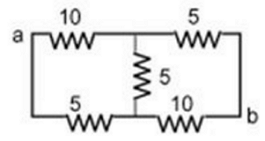Equivalent resistance

Find the equivalent resistance between and .
This section requires Javascript.
You are seeing this because something didn't load right. We suggest you, (a) try
refreshing the page, (b) enabling javascript if it is disabled on your browser and,
finally, (c)
loading the
non-javascript version of this page
. We're sorry about the hassle.
I assumed potential difference of 10V AND MADE EQUATIONS . is there a shorter way?????????????